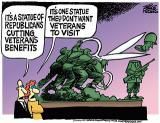11/08/2011 - FORT HOOD, Texas — By next summer, this sprawling Army post will be more crowded than it has been since U.S. soldiers began pouring into twin war zones a decade ago. With combat operations ending in Iraq and slowing in Afghanistan, times are changing at what has been the Army’s busiest deployment hub since 2001.
But while Fort Hood braces for the return of nearly 20,000 American soldiers, many of whom have served three, four or five tours overseas, Army leaders are struggling with the unprecedented task of reintegrating soldiers who have known nothing but war for the past decade.
That same challenge is faced by the entire nation as it seeks to celebrate its service members this week by marking Veterans Day. Experts warn that America is stumbling into uncharted waters as it deals with the return of hundreds of thousands of troops — the 1 percent of the nation that shouldered the load of America’s two longest wars.
There is no historical precedent for the cycle of deployments that marked the Iraq and Afghanistan wars. In Vietnam, the vast majority of service members served a single, 12-month tour; in World Wars I and II, most troops were also deployed just once, remaining on active duty until the end of the conflict.
But over the past decade of war in the Middle East, soldiers deployed, returned home, then deployed again, a cycle of churn that Army psychiatrists knew was wreaking havoc on the psyche and families of many service members.
The toll, however, has far outpaced initial estimates: More than 700,000 Iraq and Afghanistan veterans have already shown up at Department of Veterans Affairs clinics and hospitals — and more than half of them have mental health conditions, according to the Austin, Texas-based group Veterans for Common Sense. read more>>>























No comments:
Post a Comment